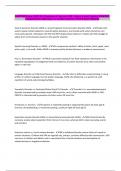AMFTRB Exam: DSM Dx | Questions & Answers (100 %Score) Latest Updated 2024/2025
Comprehensive Questions A+ Graded Answers | With Expert Solutions
Autism Spectrum Disorder (ASD) vs. Social Pragmatic Communication Disorder (SCD) - ✔✔People with
autism repeat certain behaviors, have disruptive behaviors, and trouble with social interaction (not
necessarily speech). Individuals with SCD will NOT display these behaviors. People with SCD struggle to
adjust their communication based on the specific situation.
Specific Learning Disorder vs. ADHD - ✔✔SLDs compromise student's ability to listen, think, speak, read,
write, spell, or do math. While ADHD is characterized by limited alertness in academic environment
Pica vs. Rumination Disorder - ✔✔PICA is persistent eating of non-food substances. Rumination is the
repeated regurgitation of undigested food not related to any other disorder (may chew and swallow
again, or spit out)
Language Disorder vs Child Onset Fluency Disorder - ✔✔LDs refer to difficulties understanding or using
written or spoken language, but not spoken language. COFD, aka Stuttering, is a specific LD, with
repetition of words and prolonged syllables.
Tourette's Disorder vs. Persistent Motor/Vocal Tic Disorder - ✔✔Tourette's is a neurodevelopmental
disorder characterized by multiple motor AND vocal tics, and is often comorbid with ADHD or OCD.
PMVTD is characterized by presence of either motor OR vocal tics.
Encopresis vs. Enuresis - ✔✔Encopresis is repeated pooping in inappropriate places (at least age 4).
Enuresis, aka bedwetting, is involuntary peeing, usually at night (at least age 5)
Separation anxiety disorder (SAD) vs. Generalized anxiety disorder (GAD) - ✔✔SAD characterized by
excessive anxiety about separation from home orl oves ones, whereas GAD is about everyday events
and activities
Selective mutism vs. Social anxiety disorder - ✔✔SM is childhood disorder where child can't speak in
certain situations. Children with SM are typically shy, anxious, and have difficulty with conversation. SAD
can occur in children and adults, and is a persistent fear of social situations and anticipation of
embarrassment or negative evaluation
, Reactive Attachment Disorder vs. Disinhibited Social Engagement Disorder - ✔✔Both can occur in
children who have severe disruptions in early care, such as institutional care, neglect or frequent
changes of caregivers. Children with RAD have difficulty forming attachments and may be emotionally
withdrawn, whereas DSED is difficulty regulating social interactions and an excessive desire for attention
and physical contact with unfamiliar adults (onset before 5)
Oppositional Defiant Disorder (ODD) vs. Conduct Disorder (CD) vs. Disruptive Mood Disregulation
Disorder (DMDD) - ✔✔ODD is characterized by disobedient, defiant, and hostile behavior towards
authority figures, CD is characterized by persistent pattern of aggressive, illegal, or destructive behavior
or towards others and/or property or violating rights of others, and DMDD is characterized by severe
recurrent temper outbursts and persistent irritability and anger.
Brief Psychotic Disorder vs. Schizophreniform Disorder vs. Schizophrenia - ✔✔Brief Psychotic Disorder is
characterized by symptoms of psychosis lasting less than ONE month, Schizophreniform Disorder is
characterized by symptoms of psychosis lasting LESS than six months, and Schizophrenia is a chronic
disorder characterized by symptoms of psychosis lasting at LEAST six months with additional negative
symptoms.
Major Depressive Disorder vs. Unspecified Depressive Disorder vs. Persistent Depressive Disorder (PDD,
prev known as dysthymia) - ✔✔MDD is characterized by one or more major depressive episodes,
Unspecified Depressive Disorder is characterized by symptoms of depression that do not meet the full
criteria for MDD or other depressive disorders, and PDD is a chronic form of depression characterized by
a depressed mood for at least 2 years and additional symptoms, such as difficulties with self-esteem,
concentration, and ability to make decisions
Bipolar I vs Bipolar II vs Cyclothymia - ✔✔BP1 includes at least one manic or mixed episodes of major
depressive episodes.
BP2 has at least one major depressive episode, with hypomanic episode (less severe form of mania)
Cyclothymia: numerous periods of hypomania and depressive symptoms, neither meeting full criteria
for full episodes
Schizoaffective Disorder vs. Bipolar I with Psychotic Features - ✔✔Schizoaffective Disorder is
characterized by symptoms of both schizophrenia and a mood disorder, while Bipolar I with Psychotic
Features is characterized by manic or mixed episodes with symptoms of psychosis, but without the co-
occurring mood disorder.




